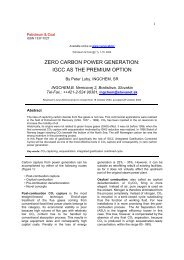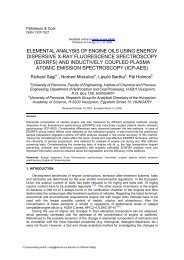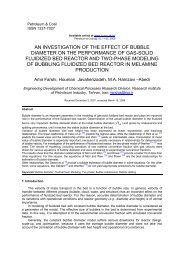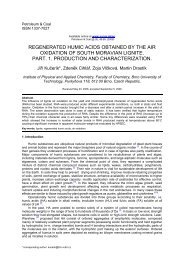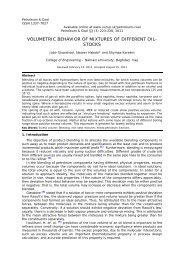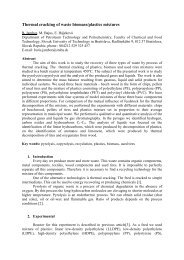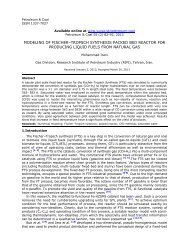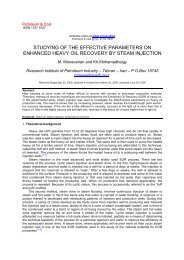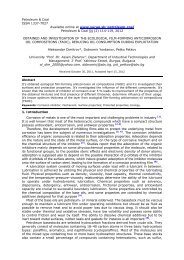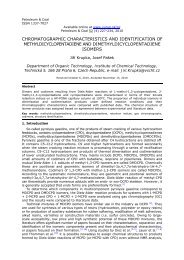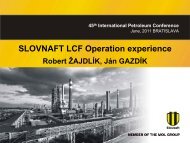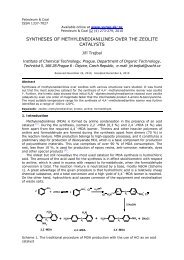prediction of nigerian crude oil viscosity using artificial neural network
prediction of nigerian crude oil viscosity using artificial neural network
prediction of nigerian crude oil viscosity using artificial neural network
Create successful ePaper yourself
Turn your PDF publications into a flip-book with our unique Google optimized e-Paper software.
182<br />
are used to estimate saturated <strong>oil</strong> <strong>viscosity</strong> (µ ob ). The saturated <strong>oil</strong> <strong>viscosity</strong> (µ ob ) and<br />
differential pressure above bubble point pressure are then used to predict undersaturated <strong>oil</strong><br />
<strong>viscosity</strong>. Some <strong>of</strong> the studies which were carried out to develop empirical correlations for<br />
the estimation <strong>of</strong> the <strong>crude</strong> <strong>oil</strong> <strong>viscosity</strong> at bubble point are below:<br />
In 1959, Chew- Connally used 457 <strong>crude</strong> <strong>oil</strong> samples to develop a graphical correlation<br />
which was later expressed mathematically by Standing, in 1981, to estimate <strong>oil</strong> saturated<br />
<strong>viscosity</strong>(µ ob ). In 1975, Beggs and Robinson collected 2,073 <strong>crude</strong> <strong>oil</strong> <strong>viscosity</strong> sets to<br />
propose an empirical correlation that estimated the saturated <strong>oil</strong> <strong>viscosity</strong> (µ ob ). The studies<br />
concluded that the performance <strong>of</strong> the correlations suffer outside the range <strong>of</strong> application [4,12,13] .<br />
3. Artificial <strong>neural</strong> <strong>network</strong>s<br />
Boomer et al. [14] and Corpoven et al. [15] defined <strong>artificial</strong> <strong>neural</strong> <strong>network</strong> (ANN) as a<br />
computing system made up <strong>of</strong> a number <strong>of</strong> simple, highly interconnected elements which<br />
process information by its dynamic response to external inputs. Mohagheh et al. [16]<br />
described that ANN is a biologically inspired computing scheme which is an analog, adaptive,<br />
distributive and highly parallel system that has been used in many disciplines and has<br />
proven to have potential in solving problems that require pattern recognition. They resemble<br />
the human brain in acquiring knowledge through learning process and in storing knowledge<br />
in interneuron connection strength [1,5,6,7,8,10] .<br />
The advantages <strong>of</strong> ANN over the conventional correlations are: <strong>neural</strong> <strong>network</strong>s have<br />
large degrees <strong>of</strong> freedom for fitting parameters, and thus, capture the systems’ non-linearity<br />
better than regression methods and they are superior to the regression models in that they<br />
could be further trained and refined when additional data become available and hence<br />
improve their <strong>prediction</strong> accuracy while it is impossible to make any further change in a<br />
linear or non linear regression model as soon as a model development is over [1,7,8,17] In this<br />
study, the back propagation <strong>neural</strong> <strong>network</strong> (BPNN) was used to model the Nigerian <strong>crude</strong><br />
<strong>oil</strong> <strong>viscosity</strong>. The BPNN is multi- layered information flows from the input to the output<br />
through at least one hidden/middle layer. Each layer contain neurons that are connected to<br />
all neurons in the neighboring layers. The connections have numerical values (weights)<br />
associated with them which will be adjusted during the training phase [1,10,12] .<br />
4. Review <strong>of</strong> literature on <strong>artificial</strong> <strong>neural</strong> <strong>network</strong>s model for <strong>crude</strong> <strong>oil</strong> <strong>viscosity</strong><br />
Several papers on <strong>neural</strong> <strong>network</strong>s have been presented to address many problems in the<br />
<strong>oil</strong> industry. Notable among the papers is the work <strong>of</strong> El-Sharkawy [12] who modeled <strong>crude</strong> <strong>oil</strong><br />
<strong>viscosity</strong> with other PVT properties for <strong>oil</strong> and gas systems <strong>using</strong> radial basis function <strong>neural</strong><br />
<strong>network</strong> (RBFNN). However, previous studies [5,6,7,8] on the use <strong>of</strong> back propagation <strong>neural</strong><br />
<strong>network</strong> (BPNN) model to predict PVT <strong>oil</strong> properties do not attempt predicting µ ob . It was<br />
also believed in the same studies that the application <strong>of</strong> <strong>neural</strong> <strong>network</strong>s required the use <strong>of</strong><br />
large number <strong>of</strong> data sets to get the desired results. The present study which aimed at<br />
predicting µ ob by developing back propagation <strong>neural</strong> <strong>network</strong> model (BPNN) has<br />
demonstrated that a reliable ANN model could in fact be developed <strong>using</strong> fewer data sets.<br />
The objectives <strong>of</strong> this study are to develop ANN models for predicting µ ob , evaluate and<br />
compare the accuracy <strong>of</strong> the ANN models to those <strong>of</strong> the empirical correlations.<br />
5. Mathematics <strong>of</strong> back propagation <strong>neural</strong> <strong>network</strong><br />
The benefit <strong>of</strong> the following mathematical derivative is to show us how the back<br />
propagation <strong>neural</strong> <strong>network</strong> (BPNN) works in reality.<br />
From Fig 1, the derivative is conducted between layer (I) and layer (K). Let I p represents the<br />
net input signals to a node (j) in a layer (J) and W ji stands for the weights <strong>of</strong> the connection<br />
from a node (i) in layer (I) to a node (j) in layer (J).<br />
Due to input pattern,X pi , I p is defined as the sum <strong>of</strong> the inputs to a node (j) or neuron (j) in<br />
the middle (hidden) layer (J) as in the shown expression:<br />
I<br />
pj<br />
=<br />
∑ W<br />
ji<br />
* X pi<br />
= net (1)<br />
J



